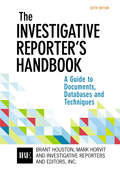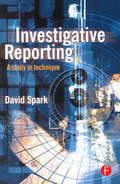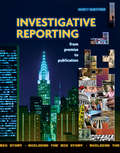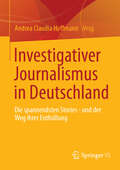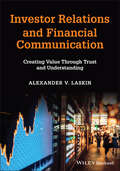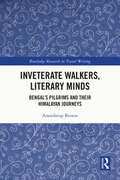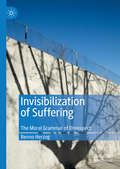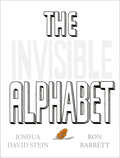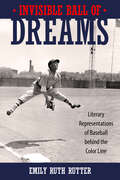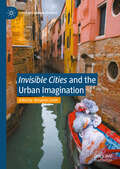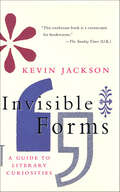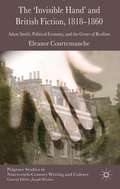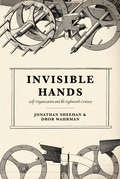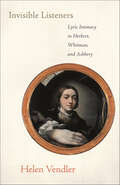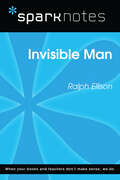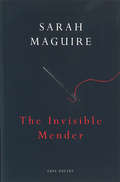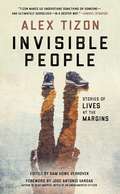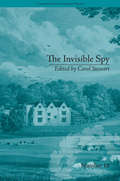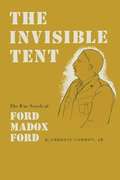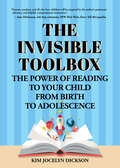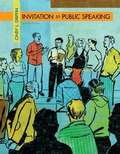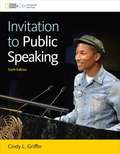- Table View
- List View
The Investigative Reporter’s Handbook: A Guide To Documents, Databases, And Techniques
by Brant Houston Mark Horvit Investigative Reporters Inc. EditorsBuild the fundamental investigative writing and reporting skills you need to investigate anything and anyone. The text’s easy-to-use handbook style allows readers to quickly access any information--everything from how to build quality reporting skills and collaborate on investigations to tips for researching a variety of beats. This is the text on investigative reporting, infused with illustrative quotes and instructive examples from highly-respected journalists around the world.
Investigative Reporting: A study in technique
by David SparkThis important book defines what investigative reporting is and what qualities it requires. Drawing on the experience of many well-known journalists in the field, the author identifies the skills, common factors and special circumstances involved in a wide variety of investigations. It examines how opportunities for investigations can be found and pursued, how informants can be persuaded to yield needed information and how and where this information can be checked. It also stresses the dangers and legal constraints that have to be contended with and shows real life examples such as the Cook Report formula, the Jonathan Aitken investigation and the Birmingham Six story. David Spark, himself a freelance writer of wide experience, examines how opportunities for investigations can be found and pursued, how informants can be persuaded to yield needed information and how and where this information can be checked. He also stresses the dangers and legal constraints that have to be contended with and shows investigators at work in two classic inquiries: · The mysterious weekend spent in Paris by Jonathan Aitken, then Minister of Defence Procurement· The career of masterspy Kim PhilbyInvestigative Reporting looks at such fields for inquiry as company frauds (including those of Robert Maxwell), consumer complaints, crime, police malpractice, the intelligence services, local government and corruption in Parliament and in overseas and international bodies.The author believes that the conclusions that emerge from this far-reaching survey are of value not only in investigative journalism, but to practitioners in all branches of reporting.
Investigative Reporting from Premise to Publication
by Marcy BurstinerThis book gives readers the confidence they need to handle any investigative reporting assignment and to produce demonstrated results. Its step-by-step progression covering the entire investigative process will help them stay on track to complete stories of any size. The book answers relevant questions such as "Where can I find a story?" "What do I do when a source won't talk?" "How can I find the right documents to support my story?" "How can I present this story online?" and "How can a spreadsheet keep it all from falling apart?" Investigative Reporting contains full stories and timely examples from both professional and student reporters. Each chapter concludes with sequential "Big Story" assignments to help readers research, write and publish their own investigative stories. Web links to online resources (including public records information, computer-assisted reporting techniques and interactive investigative story examples) will help readers move smoothly and successfully through an investigative story or team reporting project, whether for print, broadcast or the Web.
Investigativer Journalismus in Deutschland: Die spannendsten Stories - und der Weg ihrer Enthüllung
by Andrea Claudia HoffmannDieser Band bietet einen Überblick über die herausragendsten investigativen Recherchen im deutschsprachigen Raum und analysiert ihre Entstehung. Dabei geht es um wichtige politische und wirtschaftliche Themen wie den Cum-ex-Skandal, Wirecard, die Akte Schlesinger, den Terroranschlag auf den Berliner Weihnachtsmarkt, rechtsradikale Netze, die Tesla-Files, die Panama-Papers, die Sprengung der Nordsee-Pipeline und vieles mehr. Die Journalisten und Journalistinnen, die hinter diesen spannenden Recherchen stehen, berichten selbst, was sie herausgefunden haben und erklären systematisch, wie sie vorgegangen sind. Nicht zuletzt verraten sie auch, was sie aus ihrer spezifischen Recherche gelernt haben - und geben Berufsanfängern nützliche Tipps. Die Zielgruppe sind Studierende des Fachgebiets Journalismus, Medienwissenschaftler und journalistische Praktiker, die sich für die Recherchen ihrer Berufskollegen interessieren.
Investment Incentives and the Global Competition for Capital: The Return Of The Dead (International Political Economy Series)
by Kenneth P. ThomasThis book considers the widespread treatment of traumatic memory in Irish fiction of the past thirty-five years. It focuses on both trauma fiction and the historical novel, and the way certain novelists looked to early events in twentieth century Irish history to engage the recent political violence in Northern Ireland beginning in 1969.
Investor Relations and Financial Communication: Creating Value Through Trust and Understanding (Handbooks In Communication And Media Ser.)
by Alexander V. LaskinEquips students and professionals with the fundamental skills and knowledge needed to succeed in investor relations and financial communication Investor Relations and Financial Communication is a comprehensive, up-to-date introduction to the investor relations and financial communication profession. Written by a leading educator and professional consultant, this authoritative textbook provides the well-rounded foundation necessary for anyone wanting to begin a career as an Investor Relations Officer (IRO). Detailed yet accessible chapters describe all essential aspects of the field, including communication skills, basic financial knowledge, legal and regulatory guidelines, professional standards and practices, and more. Organized in five sections, the book first identifies and defines the jobs available in investor relations and financial communication, detailing the responsibilities, titles, salaries, and key players in the industry. After thoroughly explaining the disclosure of financial and non-financial information, the author describes the regulatory environment in which professionals operate and offers expert insight into issues of corporate governance, environmental sustainability, social responsibility, shareholder activism, and crisis management. Subsequent sections highlight the day-to-day activities of investor relations and financial communication professionals and discuss the future of the field. This invaluable textbook also: Describes the responsibilities of the Investor Relations Officer throughout initial public offering, periodic reporting, and performance evaluation Discusses the role of investor relations professionals in disclosing financial information and educating the investment community Emphasizes the various skills that IROs must possess in order to do their jobs successfully, such as marketing and securities law compliance Includes end-of-chapter review questions, activities, and lists of key terms Investor Relations and Financial Communication: Creating Value Through Trust and Understanding is the perfect textbook for both professional development training programs and undergraduate and graduate courses in investor relations, and is required reading for all those working in investor relations, particularly early-career professionals.
Inveterate Walkers, Literary Minds: Bengal’s Pilgrims and Their Himalayan Journeys (Routledge Research in Travel Writing)
by Anandarup BiswasInveterate Walkers, Literary Minds: Bengal’s Pilgrims and Their Himalayan Journeys brings under its critical focus the writings of Bengal’s travellers (mostly pilgrims) who went, on foot, into Himalayan trails from the mid-nineteenth to the early and mid-twentieth century. Unlike many European travellers and climbers in the age of empire, who saw the mountain as an obstacle overcoming which was a matter of individual and national pride, these modest walkers, unkempt and raddled in their meagre ways of travel, produced a discourse of surrender in their intimate and reflecting engagement with the mountains. The book examines the writings of Jadunath Sharbadhikary, the first among Bengal’s pilgrims whose Himalayan travels were published as a book and the more popular writers including Jaladhar Sen, Umaprasad Mukhopadhyay and Abadhut. It also traces emergent selfhoods and complex subjectivities of women travellers in particular, such as Ratnamala Devi, Rani Chanda and Nabaneeta Deb Sen whose accounts reveal both guarded, hesitant voices and self-assured, confident enunciation of the self.
Invisibilization of Suffering: The Moral Grammar of Disrespect
by Benno HerzogThis book offers a comprehensive theory of invisibility as a critical sociological concept, addressing the relationship between social suffering and invisibilization. Herzog draws on social theory and a variety of empirical examples to analyze social grammar and unveil various mechanisms of social suffering. Presenting an original theory of silencing and suffering, this book outlines a substantive theory and methodology of invisibilization as an instrument of authority. This systemic analysis of visibility as both a liberating and dominating mechanism will be a major contribution to the field of critical theory, offering an original framework to help improve the situation of excluded groups and individuals.Invisibilization of Suffering will be an invaluable resource for students and scholars across sociology, social philosophy, social work, political sciences, criminology, linguistics and education, with a focus on justice theory, marginalization, discrimination and exclusion.
The Invisible Alphabet
by Joshua David SteinAn ABC of things unseen: from Air to Zero, and Nothing in between.A is for AirB is for Bare C is for ClearThere is nothing to see in this A to Z, other than clues to what was once or may soon be there. The 26 alphabetical scenarios are conceptual, mysterious, and meticulous, deliberately hinting at a story that has happened off the page. Readers are encouraged to explore each letter and soak in the wonder and curiosity of the alphabet unseen. Cleverly illustrated by the beloved Ron Barrett of Cloudy with a Chance of Meatballs, this hardcover picture book is less about the letters you see, and more about the story you don't.
Invisible Ball of Dreams: Literary Representations of Baseball behind the Color Line
by Emily Ruth RutterWinner of the 2018 John Coates Next Generation Award from the Negro Leagues Research Committee of the Society for American Baseball Research Although many Americans think of Jackie Robinson when considering the story of segregation in baseball, a long history of tragedies and triumphs precede Robinson’s momentous debut with the Brooklyn Dodgers. From the pioneering Cuban Giants (1885-1915) to the Negro Leagues (1920-1960), Black baseball was a long-standing staple of African American communities. While many of its artifacts and statistics are lost, Black baseball figured vibrantly in films, novels, plays, and poems. In Invisible Ball of Dreams: Literary Representations of Baseball behind the Color Line, author Emily Ruth Rutter examines wide-ranging representations of this history by William Brashler, Jerome Charyn, August Wilson, Gloria Naylor, Harmony Holiday, Kevin King, Kadir Nelson, and Denzel Washington, among others. Reading representations across the literary color line, Rutter opens a propitious space for exploring Black cultural pride and residual frustrations with racial hypocrisies on the one hand and the benefits and limitations of white empathy on the other. Exploring these topics is necessary to the project of enriching the archives of segregated baseball in particular and African American cultural history more generally.
"Invisible Cities" and the Urban Imagination (Literary Urban Studies)
by Benjamin LinderIn 1972, Italo Calvino published Invisible Cities, a literary book that masterfully combines philosophy and poetry, rigid structure and free play, theoretical insight and glittering prose. The text is an extended meditation on urban life, and it continues to resonate not only among literary scholars, but among social scientists, architects, and urban planners as well. To commemorate the 50th anniversary of Invisible Cities, this collection of essays serves as both an appreciation and a critical engagement. Drawing from a wide array of disciplinary perspectives and geographical contexts, this volume grapples with the theoretical, pedagogical, and political legacies of Calvino’s work. Each chapter approaches Invisible Cities not only as a novel but as a work of evocative ethnography, place-writing, and urban theory. Fifty years on, what can Calvino’s dreamlike text offer to scholars and practitioners interested in actually existing urban life?
Invisible Forms: A Guide to Literary Curiosities
by Kevin JacksonDedications, Titles, Epigraphs, Footnotes, Prefaces, Afterwords, Indexes... These and other "invisible" literary necessities form the skeletons of many a book, yet these unacknowledged and unexamined forms abound in wisdom, curiosities, or eccentricities.With both erudition and wit, and drawing on examples from every part of literature's history, ranging from the greats such as Shakespeare, Beckett, and T. S. Eliot to lesser known writers such as Fernando Pessoa. Jackson's mixture of serious literary analysis and jovial wit means Invisible Forms will appeal to anyone who is interested in books and in the art of writing. It is the perfect companion for literature lovers everywhere.
The "Invisible Hand" and British Fiction, 1818-1860
by Eleanor CourtemancheThe 'invisible hand', Adam Smith's metaphor for the morality of capitalism, is explored in this text as being far more subtle and intricate than is usually understood, with many British realist fiction writers (Austen, Dickens, Gaskell, Eliot) having absorbed his model of ironic causality in complex societies and turned it to their own purposes.
Invisible Hands
by Jonathan Sheehan Dror WahrmanWhy is the world orderly, and how does this order come to be? Human beings inhabit a multitude of apparently ordered systems--natural, social, political, economic, cognitive, and others--whose origins and purposes are often obscure. In the eighteenth century, older certainties about such orders, rooted in either divine providence or the mechanical operations of nature, began to fall away. In their place arose a new appreciation for the complexity of things, a new recognition of the world's disorder and randomness, new doubts about simple relations of cause and effect--but with them also a new ability to imagine the world's orders, whether natural or manmade, as self-organizing. If large systems are left to their own devices, eighteenth-century Europeans increasingly came to believe, order will emerge on its own without any need for external design or direction. In Invisible Hands, Jonathan Sheehan and Dror Wahrman trace the many appearances of the language of self-organization in the eighteenth-century West. Across an array of domains, including religion, society, philosophy, science, politics, economy, and law, they show how and why this way of thinking came into the public view, then grew in prominence and arrived at the threshold of the nineteenth century in versatile, multifarious, and often surprising forms. Offering a new synthesis of intellectual and cultural developments, Invisible Hands is a landmark contribution to the history of the Enlightenment and eighteenth-century culture.
Invisible Listeners: Lyric Intimacy in Herbert, Whitman, and Ashbery
by Helen VendlerWhen a poet addresses a living person—whether friend or enemy, lover or sister—we recognize the expression of intimacy. But what impels poets to leap across time and space to speak to invisible listeners, seeking an ideal intimacy—George Herbert with God, Walt Whitman with a reader in the future, John Ashbery with the Renaissance painter Francesco Parmigianino? In Invisible Listeners, Helen Vendler argues that such poets must invent the language that will enact, on the page, an intimacy they lack in life.Through brilliantly insightful and gracefully written readings of these three great poets over three different centuries, Vendler maps out their relationships with their chosen listeners. For his part, Herbert revises the usual "vertical" address to God in favor of a "horizontal" one-addressing God as a friend. Whitman hovers in a sometimes erotic, sometimes quasi-religious language in conceiving the democratic camerado, who will, following Whitman's example, find his true self. And yet the camerado will be replaced, in Whitman's verse, by the ultimate invisible listener, Death. Ashbery, seeking a fellow artist who believes that art always distorts what it represents, finds he must travel to the remote past. In tones both tender and skeptical he addresses Parmigianino, whose extraordinary self-portrait in a convex mirror furnishes the poet with both a theory and a precedent for his own inventions.By creating the forms and speech of ideal intimacy, these poets set forth the possibility of a more complete and satisfactory human interchange—an ethics of relation that is uncoerced, understanding, and free.
Invisible Man (SparkNotes Literature Guide Series)
by SparkNotesInvisible Man (SparkNotes Literature Guide) by Ralph Ellison Making the reading experience fun! Created by Harvard students for students everywhere, SparkNotes is a new breed of study guide: smarter, better, faster. Geared to what today's students need to know, SparkNotes provides: *Chapter-by-chapter analysis *Explanations of key themes, motifs, and symbols *A review quiz and essay topicsLively and accessible, these guides are perfect for late-night studying and writing papers
The Invisible Mender
by Sarah MaguireLucid, complex, sensual and richly textured, the poems in The Invisible Mender are notable for the breadth of their subject matter and the precision of their detail. We travel on journeys through landscapes dense with historical and political meanings, from the post-industrial decline of frozen North America to the stymied fecundity of a London garden paralysed in a heatwave: each emotional and physical climate explored and illuminated by the writer's astonishing images and searching intelligence. This is the work of unusual power and frankness, unflinching in its steady examination of grief and love, as in the heartbreaking title poem about the poet's loss of her first mother. But here, and in the magnificent long poem 'The Hearing Cure' this explicit engagement with what is difficult also reveals the redemptive, healing force of language. Sarah Maguire's outstanding first collection of poems, Spilt Milk, was published to considerable critical acclaim and led to her being chosen as one of the New Generation Poets. The Invisible Mender, her eagerly awaited second volume, will confirm her reputation as one of the most exciting young poets in Britain.
Invisible People: Stories of Lives at the Margins
by Alex Tizon Sam Howe Verhovek“Somewhere in the tangle of the subject’s burden and the subject’s desire is your story.”—Alex Tizon Every human being has an epic story. The late Pulitzer Prize–winning writer Alex Tizon told the epic stories of marginalized people—from lonely immigrants struggling to forge a new American identity to a high school custodian who penned a New Yorker short story. Edited by Tizon’s friend and former colleague Sam Howe Verhovek, Invisible People collects the best of Tizon’s rich, empathetic accounts—including “My Family’s Slave,” the Atlantic magazine cover story about the woman who raised him and his siblings under conditions that amounted to indentured servitude. Mining his Filipino American background, Tizon tells the stories of immigrants from Cambodia and Laos. He gives a fascinating account of the Beltway sniper and insightful profiles of Surfers for Jesus and a man who tracks UFOs. His articles—many originally published in the Seattle Times and the Los Angeles Times—are brimming with enlightening details about people who existed outside the mainstream’s field of vision. In their introductions to Tizon’s pieces, New York Times executive editor Dean Baquet, Atlantic magazine editor in chief Jeffrey Goldberg, Pulitzer Prize winners Kim Murphy and Jacqui Banaszynski, and others salute Tizon’s respect for his subjects and the beauty and brilliance of his writing. Invisible People is a loving tribute to a journalist whose search for his own identity prompted him to chronicle the lives of others.
The Invisible Spy: by Eliza Haywood (Chawton House Library: Women's Novels #18)
by Carol StewartInterest in the work of Eliza Haywood has increased greatly over the last two decades. Though much scholarship is focused on her ‘scandalous’ early career, this critical edition of The Invisible Spy (1755) adds to the canon of her later, more sophisticated work.
Invisible Storytellers: Voice-Over Narration in American Fiction Film
by Sarah KozloffSarah Kozloff examines and analyzes voice-over narration through examples from films and refutes the assumptions that words should only play a minimal role in film, that "showing" is superior to "telling," or that the technique is inescapably authoritarian.
The Invisible Tent: The War Novels of Ford Madox Ford
by Ambrose Gordon Jr.This critical evaluation of Ford Madox Ford's "novels of war, which are also novels about peace," is made in a most delightful manner. Based on a thorough knowledge of the novelist, it is enriched by keen perception and delicate taste and is couched in an informal, highly readable style. Ambrose Gordon, Jr. , here analyzes seven novels by Ford that in Gordon's opinion constitute Ford's masterpieces: Parade's End (a tetralogy consisting of Some Do Not, No More Parades, A Man Could Stand Up, and The Last Post), The Marsden Case, No Enemy, and The Good Soldier. Interested in what these novels have to say, Gordon is equally interested in how they make their comment, and so approaches them through analysis of the fictional methods that Ford employed. Yet he skillfully avoids a common error of critics who become absorbed in technique-loss of contact with the book itself-by providing numerous quotations of sufficient length to indicate the novels' quality. These passages, examined in detail for content and technique, give the reader an understanding of the novel that, though not a substitute for one's own reading of the narratives, is enhanced by the interpretation of a brilliant critic. Gordon traces the development of the novelist's art in various phases: the characteristic moods and general patterns of his novels, his borrowings from the French, the effects of his association with Conrad, his concept of the novel as fairy tale, his use of scene exteriors and interiors. Gordon's discussion cuts across the seven novels in many aspects but concentrates on one novel, or a group of novels, when his ideas have less general illustration.
The Invisible Toolbox: The Power of Reading to Your Child from Birth to Adolescence
by Kim Jocelyn DicksonAn Essential Tool for Preparing Your Child for Kindergarten and BeyondReading aloud to your children is essential. Longtime elementary school teacher Kim Jocelyn Dickson believes every child begins kindergarten with a lunchbox in one hand and an “invisible toolbox” in the other. In The Invisible Toolbox, Kim shares with parents the single most important thing they can do to foster their child’s future learning potential and nurture the parent-child bond that is the foundation for a child’s motivation to learn. She is convinced that the simple act of reading aloud has a far-reaching impact that few of us fully understand and that our recent, nearly universal saturation in technology has further clouded its importance.In The Invisible Toolbox, parents, educators, and early literacy advocates will discover:Ten priceless tools that will fill their child’s toolbox when they read aloud to their childTools parents can give themselves to foster these gifts in their childrenPractical tips for how and what to read aloud to children through their developmental stagesDos and don’ts and recommended resources that round out all the practical tools a parent will need to prepare their child for kindergarten and beyondEssential book for parents. In The Invisible Toolbox, Kim weaves her practical anecdotal experience as an educator and parent into the hard research of recent findings in neuroscience. She reminds us that the first years of life are critical in the formation and receptivity of the primary predictor of success in school—language skills—and that infants begin learning immediately at birth. She also teaches and inspires us to build our own toolboxes so that we can help our children build theirs.If you enjoyed books like Honey for a Child's Heart, The Read-Aloud Handbook, Screenwise, or The Enchanted Hour; you will love The Invisible Toolbox—from a 21st century Charlotte Mason.
Invitation to Public Speaking (2nd edition)
by Cindy L. GriffinFor this second edition of an introductory text, Griffin (speech communication, Colorado State University) expands the text's focus to emphasize public speaking as public dialogue. There is more material on civic engagement, service learning, and plagiarism, plus six new student speeches and updated examples. The text provides instructions for specific speech construction, delivery, and strategy steps, with material on technology as a learning tool and in speech preparation integrated throughout. Learning features include chapter summaries, review questions, and Internet activities.
Invitation To Public Speaking - National Geographic Edition
by Cindy GriffinGrounded in rhetorical tradition while offering a fresh perspective, INVITATION TO PUBLIC SPEAKING helps students understand the power and importance of public speaking--in their lives and in greater society. Intended for the introductory public speaking course, INVITATION TO PUBLIC SPEAKING engages students in the public dialogue, encourages civic engagement, and illustrates how they will apply speaking skills in their course work and throughout their careers. Speech-building exercises, thoughtful real-life examples, an invigorating art program, and an engaging voice help students comprehend public speaking as an activity to be engaged in with others, and prepares them to enter the public dialogue. INVITATION TO PUBLIC SPEAKING also features the most comprehensive integrated technology program available, giving students more interactive skill-building practice for public speaking.
Inviting Interruptions: Wonder Tales in the Twenty-First Century (Series in Fairy-Tale Studies)
by Su Blackwell Shary Boyle Susanna Clarke Emma Donoghue Rosario Ferré Associate Professor Nalo Hopkinson Anne Kamiya David Kaplan Maya Kern Bryan Kamaoli Kuwada Kelly Link Dan Taulapapa McMullin Rosalind Hyatt Orme Diriye Osman Joellyn Rock Sofia Samatar Veronica Schanoes Nisi Shawl Shaun Tan Danielle Wood Miwa YanagiInviting Interruptions: Wonder Tales in the Twenty-First Century anthologizes contemporary stories, comics, and visual texts that intervene in a range of ways to challenge the popular perception of fairy tales as narratives offering heteronormative happy endings that support status-quo values. The materials collected in Inviting Interruptions address the many ways intersectional issues play out in terms of identity markers, such as race, ethnicity, class, and disability, and the forces that affect identity, such as non-normative sexualities, addiction, abuses of power, and forms of internalized self-hatred caused by any number of external pressures. But we also find celebration, whimsy, and beauty in these same texts—qualities intended to extend readers’ enjoyment of and pleasure in the genre. Edited by Cristina Bacchilega and Jennifer Orme, the book is organized in two sections. "Inviting Interruptions" considers the invitation as an offer that must be accepted in order to participate, whether for good or ill. This section includes Emma Donoghue’s literary retelling of "Hansel and Gretel," stills from David Kaplan’s short Little Red Riding Hood film, Bryan Kamaoli Kuwada’s story about stories rooted in Hawaiian tradition and land, and Shary Boyle, Shaun Tan, and Dan Taulapapa McMullin’s interruptions of mainstream images of beauty-webs, commerce, and Natives. "Interrupting Invitations" contemplates the interruption as a survival mechanism to end a problem that has already been going on too long. This section includes reflections on migration and sexuality by Diriye Osman, Sofia Samatar, and Nalo Hopkinson; and invitations to rethink human and non-human relations in works by Anne Kamiya, Rosario Ferré, Veronica Schanoes, and Susanna Clark. Each text in the book is accompanied by an editors’ note, which offers questions, critical resources, and other links for expanding the appreciation and resonance of the text. As we make our way deeper into the twenty-first century, wonder tales—and their critical analyses—will continue to interest and enchant general audiences, students, and scholars.
